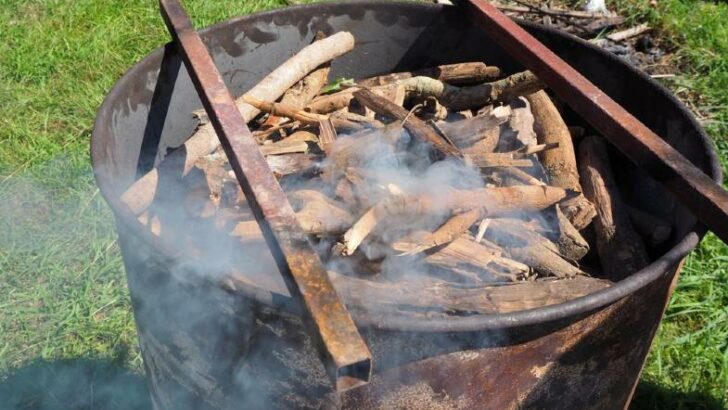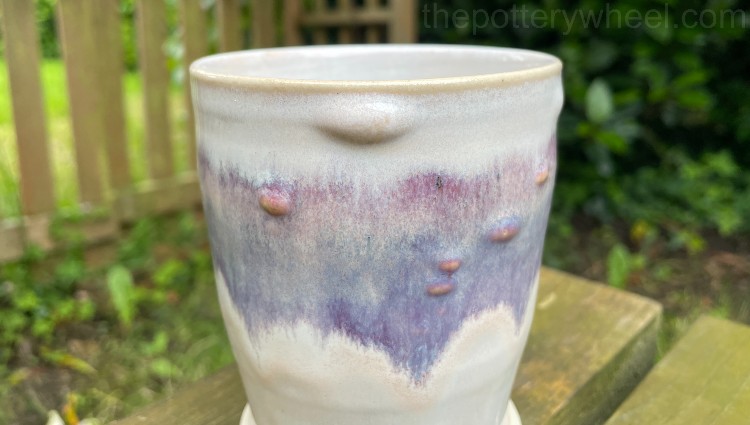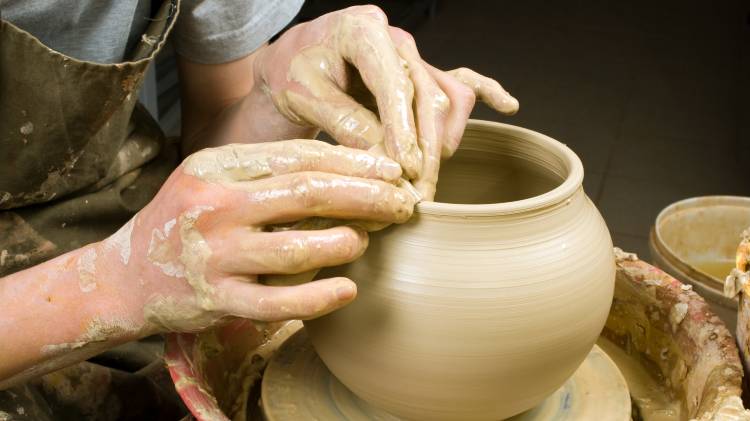There are numerous ways to build a kiln for pottery in your backyard. It needn’t be expensive or complicated. In essence, you are making a chamber that can get up to high temperatures and stay there.
Disclaimer: This article is for informational purposes and is not intended as advice about building a kiln. Kilns can be dangerous. If you have any safety concerns please consult with a relevant professional for guidance.
On that note of caution, here are some easy and inexpensive ways to build a kiln for pottery.
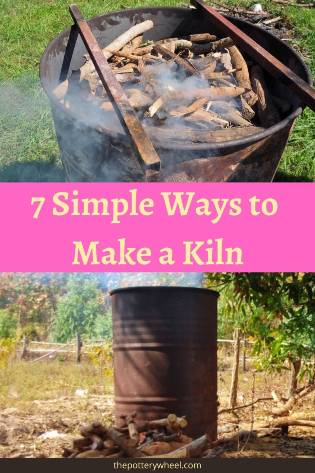
How to Build a Kiln for Pottery: Method 1
Pit Firing
Pit firing is one of the oldest methods of firing pottery. If you want to build a kiln for pottery in your backyard, this is one of the simplest. You don’t require any particular equipment, other than a shovel and some combustible material.
Pit firing can be used to fire greenware pottery and make it bisqueware. Or, you can bisque fire the pottery first, then wrap the bisqueware in aluminum saggars. The saggars allow you to add lovely decorative finishes to your pots. I will say a little more about this later.
How to Pit Fire Pottery
First, let’s have a look at how you actually pit fire your pottery. If you are going to pit fire, you need to be prepared to dig a hole in your backyard. The size of the pit depends on the size and quantity of pottery that you want to fire. If you have a smallish collection (say 5 or 6 small pots), a pit of around 1 foot is adequate.
The pit needs to be deep enough to protect the fire from the wind. But not so deep that the fire is starved of oxygen. If there isn’t sufficient airflow the fire in the pit won’t reach high enough temperatures.
Pit fires can reach around 2,000F (1,100C) at their highest temperature. So, even at their highest temperature, they are a low fire method, and the pottery produced is earthenware.
If you are bisque firing greenware in the pit, it’s a good idea to do a pre-heat. You can do this by lining your pottery up around the side of the pit and burning a fire. This is a little like candling your pots. The heat of the fire drives out moisture and helps prevent it from cracking in when put in the pit.
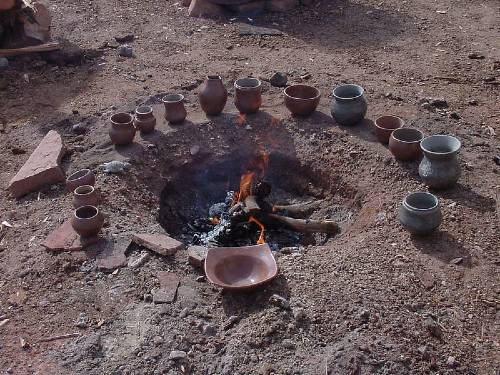
If your pottery is bisque fired, a pre-heat is not necessary. Different potters use different combustible materials. One way of pit firing is to line the pit with sawdust. This is basically kindling. Then place the pots on the kindling, and carefully cover the pots with sticks and wood. You do this as you would build a fire. Starting off with smaller pieces of wood that burn more easily and building up to larger pieces on top.
Colors and Flashing Effects in a Pit Fire
There are various ways to add flashes of color to your potter. One way is to sprinkle powdered oxides into the sawdust and wood material as you are building the fire. Good examples are copper carbonate and red iron oxide.
You can make little paper packets of the oxides and put them amongst the sawdust and wood. Or you can sprinkle the powder directly onto the combustible material.
Alternatively, you can make saggars for your pottery and put the oxides into the saggars. You can make saggars out of foil or by wrapping your pottery in organic matter such as banana skins. Potters will also wrap their pottery in leaves or sweet corn leaves.
In addition, you can add other agents like salt and copper wire. All of these materials will add interesting colors and flashing effects to your pottery.
However, you don’t have to use salt and coloring oxides. Nor do you have to use saggars. If you simply place your pots directly into the fire, they will take on a smoky, intense, blackened look
The Pit Firing Process
With pit firing, you need to continue to feed the fire with wood or combustible material. Once the fire is well established, some potters will use a metal flue over the fire to contain the heat.
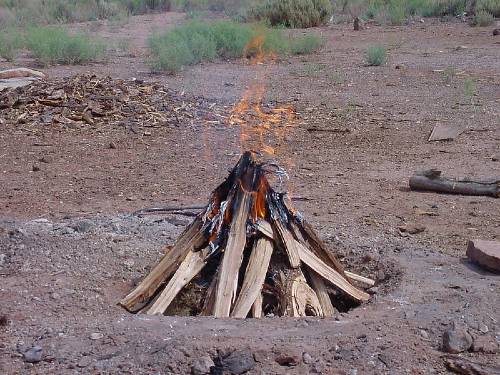
A bisque fire can last around 5 to 6 hours. Towards the end of the fire the flames will have died down and the embers will be glowing.
Some potters will cover the embers with sand, peat, or dung to reduce oxygen levels in the pit. This causes a reduction atmosphere and will intensify the blackened, carbonized look.
Once the pit has cooled down, often overnight, you can uncover the pottery carefully. It will be covered in carbon and soot and will need cleaning. Once cleaned up it can look stunning.
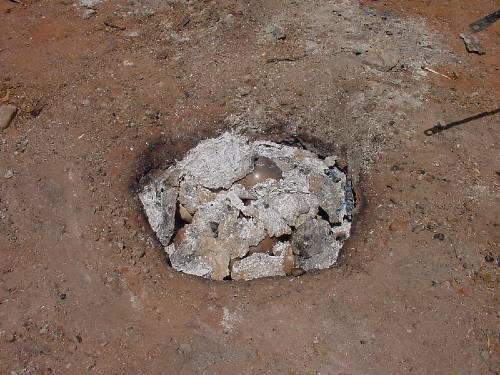
How to Build a Kiln for Pottery: Method 2
Brick Kilns
Another way to build a kiln for pottery in your backyard is to use bricks. There are various different ways to build a kiln for pottery out of bricks.
Some types of brick kilns are sometimes described as being a version of pit firing. The reason for this is that brick kilns can work on the same principle of pit firing.
For example, some potters will make a pit in the ground and then line the pit with bricks.
Other potters will use brick to build a construction above the ground. Although they are building the bricks upward, rather than digging downward, the firing method is similar to pit firing.
With some brick kilns, you are simply creating a pit into which can put combustible material and pottery. It’s just that the pit is being fashioned out of bricks rather than dug into the ground.
There are various different designs for building a brick kiln. You can make your kiln square or cylindrical. Square brick kilns are easier to build. So, if you are starting off, you might want to try a square one first.
Some potters advise using fire bricks to build a brick kiln. These can cope with high temperatures. Regular building bricks can sometimes crack with heat.
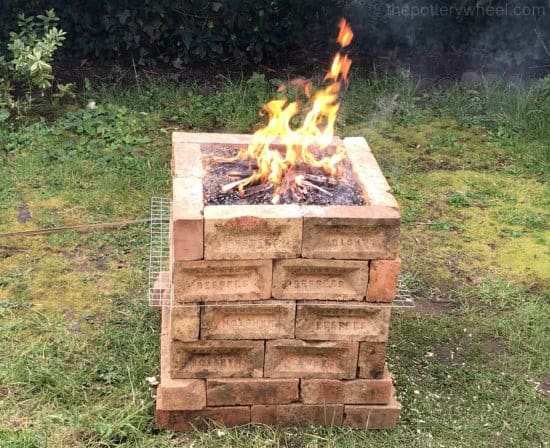
Nevertheless, a lot of potters will use regular building bricks. In fact, environmentally-minded potters prefer to use reclaimed bricks. In an ideal world, you would find a pile of old bricks that you could reuse. It’s possible to buy reclaimed bricks.
However, they’re popular with property builders because they have more character than new bricks. So, ironically, they are more expensive than new bricks.
Building a Simple Brick Kiln:
After you have found a safe place to build your kiln, put a couple of layers of bricks on the ground. This will be the base of the kiln.
Decide before how large you want the kiln to be. This will depend on the size of the pieces you want to fire. If you have a selection of small pots, a kiln that is about 3 feet square is a manageable size.
Once you have built the base, you can start building up the brick walls. Obviously, if you make the walls around 3 feet tall, your kiln will be square.
You can add a shelf into the kiln by sandwiching a metal grid halfway up the kiln. To add the shelf, simply rest the grid across the brick walls. Then add the next layer of bricks on top of the grid.
The top layer of bricks needs to have some gaps in it to allow for ventilation. Smoke and fumes need to escape. Plus, a gap will allow a through draft, bringing in oxygen to keep the kiln alight. You can create ventilation by taking a few bricks out of one side at the top.
For a step-by-step guide on how to build and use a sawdust kiln, check out my video.
Using a Simple Brick Kiln:
Once you have the base and walls built, you can load your kiln. As with pit firing, potters use different combustible materials to burn in brick kilns. It’s common however to start off with a layer of sawdust. Sometimes these are mixed with wood pellets or wood chips.
Nestle a layer of pottery in the mix, and then cover this with more sawdust and or wood chips. You can then repeat this process adding another layer of pottery. A metal grid shelf will allow you to put a few layers of pottery into the brick kiln.
Once the pottery has been loaded, you can use paper or dried leaves as kindling on the top of the pile.
As the fire burns, you can add larger pieces of wood as you would a normal fire. When the fire is established you can cover the top with a sheet of corrugated iron. It’s a good idea to weigh this down with some more bricks.
A simple brick kiln like this can burn for around 12 hours. Eventually the sawdust and wood will burn itself out. Once the kiln is cool you can start to unpack it.
You can download a free ebook on exactly how to build and fire a simple brick sawdust kiln here…
How to Build a Kiln for Pottery: Method 3
Primitive Mud/Clay Kilns
Another very old way of making a kiln is to build it out of mud or clay. Often the motivation for building a mud or clay kiln is to learn primitive techniques. The clay is often dug up from the ground nearby. Potters use different materials. Some use mud or puddled adobe, others use clay or mix the clay with straw to make it stronger.
There are various different ways of doing this, some with more complex designs than others.
Put simply, a clay kiln is made by building a cylinder of mud that is like a thick-walled barrel. A very simple design will have an opening at the bottom of the cylinder where wood is fed into the base.
More complicated designs involve building a clay tunnel that runs out of this opening. This is tunnel protects the fire from wind and makes more room for fuel to be added to the fire.
The bottom of the kiln becomes a firebox by putting a clay shelf above where the fire burns. Holes are made on the shelf so that the heat, fire, and atmosphere can pass through the kiln. The shelf can also be made out of a metal grid.
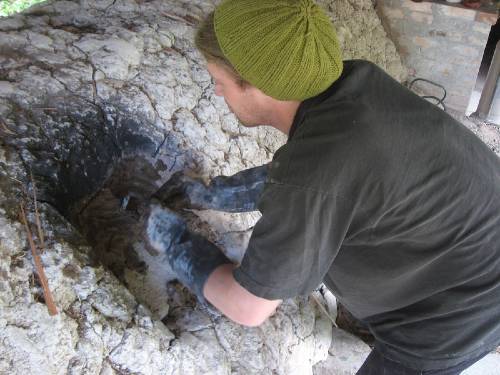
How Does a Mud/Clay Kiln Work?
A mixture of smoke and heat passes out of the top of the kiln. Air is drawn through the opening at the bottom and passes through the kiln to a chimney at the top. It is essentially a convection kiln.
Pots are placed on the top of the shelf and are fired as the kiln heats up. Wood is fed into the kiln through the opening at the base to keep the temperature high.
Slabs of stone, clay, or concrete can be placed on the top of the chimney. This allows you to adjust the aperture of the flue, and the heat in. There need to be some gaps in the covering to allow for ventilation. But not so much that all the heat escapes.
How to Build a Kiln for Pottery: Method 4
Barrel Kilns
Barrel kilns are considered to be another variation of pit firing. Like the brick kilns described earlier, a barrel kiln essentially works like an above-ground pit kiln.
Similar to the other methods of building a kiln for pottery, there are different types of barrel kiln. They vary in design and complexity.
Simple Barrel Kilns
Some potters simply fire in a barrel or steel garbage can. They adapt the barrel by drilling a few holes around the base of the can. This allows for airflow. Airflow can be enhanced by putting a layer of pea gravel in the base of the barrel.
A layer of combustible material is placed on the gravel. This can be a combination of wood chips, sawdust, and shredded paper. Pottery is placed on the first layer of burnable material.
This layer of pottery is then covered over again with more wood. As with the other methods, oxides and salt can be sprinkled in to create flashes of color.
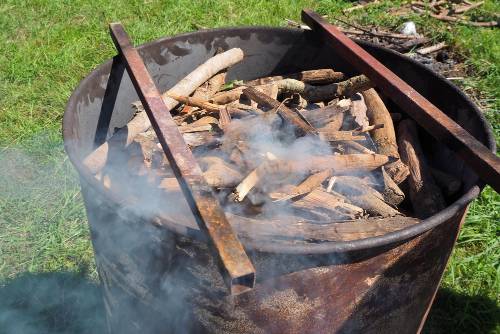
Once the barrel is loaded, the mixture of wood, paper, and sawdust is set alight. The lid is then placed on the barrel and left to burn.
More Complex Barrel Kilns
A barrel can be made into an updraft kiln or a downdraft kiln. In an updraft kiln, the air is drawn in the bottom of the kiln. It then travels up and exits from a flue on the top. With a downdraft kiln, the opposite occurs. The air is drawn in the top, travels down, and is expelled through a flue attached to the base.
A barrel can be made into an updraft kiln by cutting openings into the side of the barrel at the bottom. And welding a chimney to the lid. Once the fire is going in the barrel, the chimney can be put on. You can control the amount of oxygen in the barrel by closing or opening the side holes at the base.
Here is a great video about potter Chris Dunn using a barrel to pit fire. He uses an updraft barrel kiln and his pottery is lovely.
Alternatively, you can make a downdraft barrel kiln, by welding a chimney outlet to the base of the barrel. Once the fire is established, the lid is put on the barrel. However, the lid is cracked so that the air can be drawn in and down.
How to Build a Kiln for Pottery: Method 5
Raku Kilns
Raku is a way of firing pottery. It involves heating pottery quite quickly to about 1800F (1000C). And taking it from the kiln with long raku tongs when it is still red hot.
The red hot pottery is then placed in burnable material like paper, sawdust, or straw. Often the hot pottery is put in a metal bucket containing the paper or straw. The burnable material catches fire because of the heat.
Once the fire is a light, a metal lid is put over the top of the bucket. This restricts the flow of oxygen in the bucket and creates a reduction atmosphere. A reduction atmosphere means that there is less oxygen in the bucket. This causes the glaze to take on particular colors and tones as it cools and goes solid.
It is possible to buy kilns that are made especially for raku firing. They have lids that lift easily and allow you to take the hot pottery out safely. They are also made so that the sudden drop in temperature when they are opened, does not damage them.
However, specially made raku kilns are quite expensive, and you can build one easily.
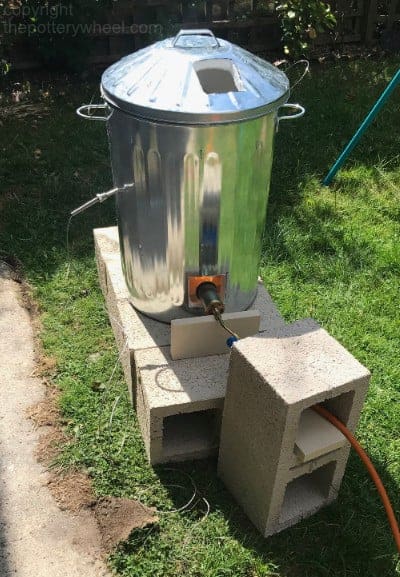
Building a DIY Raku Kiln
There are a few ways of making a raku kiln. However, one of the most popular ways, is to make a trash can raku kiln.
A trash can raku kiln is made from an old cleaned-out oil barrel or galvanized steel trash can. You cut a 4 x 4-inch square at the bottom of the can. This is the hole into which your flame will be directed. Then you cut a 4 x 4-inch hole in the lid of the can.
The can is then lined with ceramic fiber. Ceramic fiber comes in rolls and can withstand high temperatures. It is fixed to the inside surface of the trash can using ceramic buttons and something called nichrome wire. Nichrome wire can also cope with high temperatures without melting.
To fire the kiln, you use a propane weed burner which is directed into the burner port at the bottom. The weed burner is attached to a tank of propane gas. You can track the rise in temperature using a thermocouple and pyrometer. A thermocouple is a piece of kit that measures very high temperatures.
To use a thermocouple, you will need to have made a hole in the side of the kiln. This hole needs to be about half the way up the side.
Once you have reached around 1800F, you typically hold the temperature there for about 5 minutes. Then you carefully lift the lid of the kiln. Using the tongs, you remove the pieces and place them in the burnable material. The reduction atmosphere and the smoke from the material will give the pottery its special raku look.
For a step-by-step guide on how to make a raku kiln, check out my video.
How to Build a Kiln for Pottery: Method 6
A Wire Mesh Kiln
A wire mesh kiln is similar to the raku kiln described above in that it is lined with ceramic fiber.
Wire mesh kilns come in various different shapes and sizes, but the easiest one to make is a square one.
As the name suggests, the walls of the kiln are made from wire mesh. These are cut to size and held together using either wire or strong metal clips. The inside surface of each side of the kiln is lined with ceramic fiber.
Like the raku kiln, a hole is cut into the bottom of one of the panels. This is the hole through which your flame will heat the kiln. The flame is provided by a weed burner torch, linked up to a propane tank.
If you want to know how to connect a weed burner to a propane tank, check out this video.
The lid of the kiln is another wire mesh panel covered with ceramic fiber on the inside surface. It has a wire handle so you can lift it off at the end of the firing.
Whilst the firing is taking place the lid should be placed a little off-center. This will make a gap along one top edge, making a flue from which fumes and gases can escape. It also allows the flames and heat to move around and pass through the kiln. Ideally, the gap should be on the opposite side of the kiln from the burner.
The ceramicist Ian Gregory specialized in designing many types of wire mesh kilns. If you are interested in this particular approach, I’d recommend checking out his book on building kilns for more information.
How to Build a Kiln for Pottery: Method 7
An Electric Kiln
Another way to build a kiln for pottery is to make an electric kiln. As with all the methods outlined above, there are quite a few ways of making an electric kiln.
The basic idea behind making an electric kiln is to run electric elements through an insulated surface. Electric elements are coils of wire through which an electric current passes. The elements heat up because of the electric current and this heats the inside kiln chamber.
One way to make an electric kiln is to make a metal frame using strips of angle metal with pre-drilled holes. The frame is then lined with fire bricks. Fire bricks are the insulating bricks used in electric kilns. They are quite soft brick and can cope with high temperatures.
Grooves are cut into the surface of the fire brick and the electric element is pinned into the groove. The grooves run right the way around the kiln so that the elements surround the inner chamber.
Two holes are drilled in the fire brick, one at the point where the element enters the kiln. The other is drilled at the point where the element leaves the kiln. The elements are then connected to an electrical supply.
Whilst making the main chamber of an electric kiln can be quite simple, you do need some electric know-how. If you don’t know about electricity, you need to involve a registered electrician in your project. The most important thing is to keep safe. So, if you don’t know what you are doing with electricity, get help from someone who does.
Safety Precautions
If you do build a kiln for pottery, here are some general safety considerations:
- It’s usually recommended that you build any kind of kiln at least 15 feet away from nearby buildings. But this may vary from region to region.
- You should check out if your local jurisdiction allows you to build a kiln for pottery in your backyard or not. And if so, if they have any particular requirements regarding the location and specification of the kiln.
- Make sure that there is no grass, vegetation, or overhanging trees that could catch alight. And make sure that the ground is even so that your construction is stable.
Final Thoughts
There are many ways to build a kiln for pottery. Some are more complicated than others. As you have read, the methods range from digging a pit in your backyard to making an electric kiln. Each method will produce quite different results with your pottery. Either way, it is entirely possible to make your own kiln and save yourself the expense of buying one.

